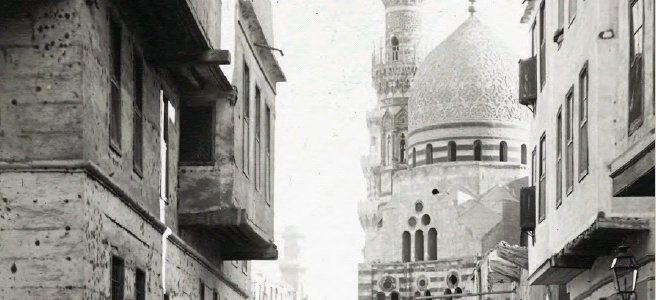Developed by InVisu and Persée, the Athar project (from Arabic “traces” or “imprints” and by extension monuments or antiquities) makes available in open access a corpus of documents (scientific literature, reports, photographic archives …) relating to monuments of Arab art of cities in the Mediterranean basin.
The first phase of the project focused on the city of Cairo. On the model of the Commission des monuments historiques in France, a committee was created in 1881 in Cairo, to inventory, describe and restore the Islamic and Coptic monuments of Egypt. The rapport de ce comité consist of 41 volumes published in Cairo between 1882 and 1953, totaling 8,000 pages and nearly 800 plates (photographs, plans and drawings). For historians and art historians working on the historiography of the arts of Islam, the history of restoration and patrimonialization, these reports constitute a unique source of primary importance, not only because of the wealth of data they contain (number of monuments described, quality of architectural and historical information, technical documentation on the restoration sites, prosopography of the actors, etc.), but also because of the gradual disappearance of these buildings in the course of the twentieth and twenty-first centuries. This type of corpus raises in particular difficulties of treatment as regards identification and indexing, because of the multiple variants resulting from the transliteration of the Arabic toponyms. InVisu has compiled a référentiel des monuments du Caire, the Cairo Gazetteer, in the form of a concordance table that lists and aligns variants of monument names, and allows buildings to be identified, described and located. Then other collections continued to feed the perseid (the Feuillets d’El Djezaïr, the publications of the Comité du vieil Alger, the booklets-catalogues of the Tunisian Salon, iconographic albums of modern Cairo from the Max Karkégi collection) backed by two other rérérérentiels: the Gazetier d’Alger and the Modern Cairo Gazetteer.
Winner of the Collex-Persée 2018 call for projects, the project entitled “Cairmod – Geo-visualization of Athar Perseid content: the case of modern Cairo” aimed to make available on the dedicated Perseid a thematic corpus with tools. The project was based on three objectives. The aim was to structure at the infra-paginary level a set of five albums already digitized by Gallica, documenting the modern city of Cairo by means of original or published photographs, as well as press clippings. This structuring was to be enriched by a repository of toponyms mentioned in the legend or identified, which was to serve as a pivot to feed a geo-visualization module linked to a geographic information system. The documentary and scientific challenge was to give an account of the urban renewal of modern Cairo over time thanks to a collection that is still unexplored because it is rather atypical. From a technological point of view, the ambition was to make semantized data, images from an IIIF server and spatial data talk. This project was based on a partnership involving the laboratory InVisu, project owner, Persée, l’Institut français d’archéologie orientale (IFAO), and École normale supérieure de Géomatique (ENSG).
More details on the project Cairmod on CollEx-Persée.
Project partners : Persée (UAR 3602), InVisu (UAR 3103)
To consult the ATHAR perséide : https://athar.persee.fr/


